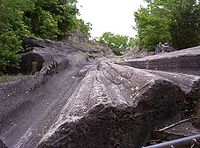
Glacial striations
Encyclopedia

Bedrock
In stratigraphy, bedrock is the native consolidated rock underlying the surface of a terrestrial planet, usually the Earth. Above the bedrock is usually an area of broken and weathered unconsolidated rock in the basal subsoil...
by process of glacial abrasion
Abrasion (geology)
Abrasion is the mechanical scraping of a rock surface by friction between rocks and moving particles during their transport by wind, glacier, waves, gravity, running water or erosion. After friction, the moving particles dislodge loose and weak debris from the side of the rock...
. Glacial striations usually occur as multiple straight, parallel grooves representing the movement of the sediment-loaded base of the glacier. Large amounts of coarse gravel and boulders carried along underneath the glacier provide the abrasive power to cut the grooves, and finer sediments also in the base of the moving glacier further scour and polish the bedrock.
Most glacial striations were exposed by the retreat of glaciers since the Last Glacial Maximum
Last Glacial Maximum
The Last Glacial Maximum refers to a period in the Earth's climate history when ice sheets were at their maximum extension, between 26,500 and 19,000–20,000 years ago, marking the peak of the last glacial period. During this time, vast ice sheets covered much of North America, northern Europe and...
or the more recent Little Ice Age
Little Ice Age
The Little Ice Age was a period of cooling that occurred after the Medieval Warm Period . While not a true ice age, the term was introduced into the scientific literature by François E. Matthes in 1939...
. As well as indicating the direction of flow of the glacial ice, the depth and extent of weathering of the gouges may be used to estimate the duration of post-glacier exposure of the rock.
An extreme example of glacial striations can be found at the Glacial Grooves at Kelleys Island, Ohio
Kelleys Island, Ohio
Kelleys Island is both a village in Erie County, Ohio, United States, and the island which it fully occupies in Lake Erie. Originally known as Island Number 6 and later Cunningham Island, it was renamed in 1840 for brothers Datus and Irad Kelley, who were largely responsible for cultivatating the...
(a National Natural Landmark
National Natural Landmark
The National Natural Landmark program recognizes and encourages the conservation of outstanding examples of the natural history of the United States. It is the only natural areas program of national scope that identifies and recognizes the best examples of biological and geological features in...
), the most impressive of which is 400 feet (121.9 m) long, 35 feet (10.7 m) wide, and up to 10 feet (3 m) deep. These grooves cut into the Columbus Limestone
Columbus Limestone
The Columbus Limestone is a mapped bedrock unit consisting primarily of fossiliferous limestone, and it occurs in Ohio, Pennsylvania, and Virginia in the United States, and in Ontario, Canada.-Stratigraphy:...
.

